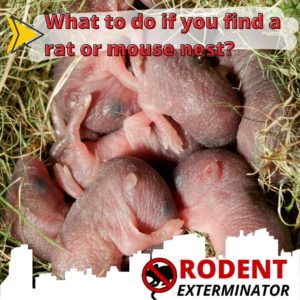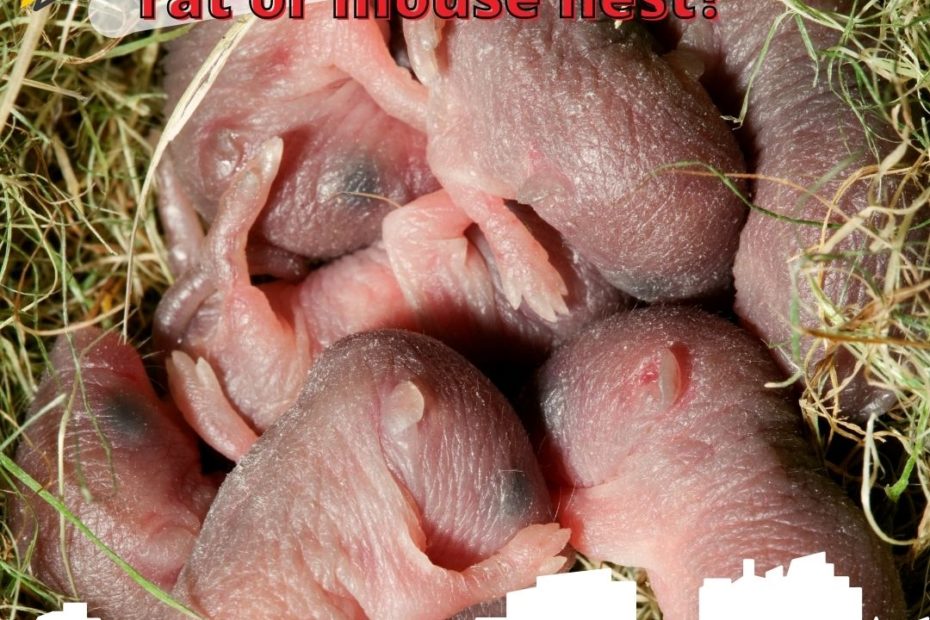Finding a stray rat wandering around inside your home or business is terrible enough, but if you have a rat or mice infestation, there is a greater danger to consider.
Rats and mice usually live in big groups and are vulnerable to the conditions inside a home with easy hiding places for a rodent’s nest.
An infestation of rats or mice can cause major damage to a home or business, as well as the possibility of diseases and health problems that come with it.
Rats and mice can carry dangerous diseases, so it’s important to take the necessary precautions if you find one of these nests in your home.
The best way to deal with a rat or mouse nest is to identify it as soon as possible. Once you have identified the nest, you can take the necessary steps to get rid of it.
Before you try to get rid of a nest, you must first get rid of the rats in the house. Because traps can take a long time to eliminate all the rodents, professional pest control is the best alternative for rat nest eradication.
To avoid the transmission of viruses, the nest should be removed and the area carefully cleansed.
 How do you know if you have a rat’s or mice’s nest?
How do you know if you have a rat’s or mice’s nest?
If you think you might have a rat or mouse nest in your home, there are a few things you can look for to help you determine if this is the case.
-
Droppings
One of the easiest ways to tell if you have a rat or mouse nest is to look for droppings.
Rats and mice leave droppings as they move around, so if you see droppings near your food or in any other areas of your home, it’s likely that you have a rat or mouse nest.
-
Tracks or footprints
If you see any evidence of tracks in your home, it’s likely that you have a rat or mouse infestation. Rats and mice often leave tracks near their nests, so if you see any evidence of tracks in your home, it’s a sign that you need to take action to get rid of the pests.
-
Noises
You may hear scurrying noises coming from the nest, especially at night.
-
Chewing
Rats and mice like to chew on things, so you may notice chewed wires or furniture near the nest.
How many rats and mice are usually in a nest?
It’s difficult to estimate how many rats or mice are usually in a nest, as the number can vary depending on the size and location of the nest.
-
Rats:
A single nest typically houses five to ten rats, though this number can be fewer for a newly built nest or slightly larger once a litter is born.
Furthermore, rats may build a colony by establishing numerous nests close together. If there is enough food, a colony can have up to a hundred rats living in it.
-
Mice:
When it comes to mice, it’s a different story. Mice reproduce frequently, fast, and do not stop reproducing unless they are eradicated.
Female mice have a three-week gestation period and can have five to twelve pups per litter. Depending on their age and the availability of other mice in the area, a mouse nest can house anywhere from a dozen to two dozen mice.
Because mice require warm, dry spaces that are well sheltered and close to a food source to rear their pups, they seek for warm, dry regions that are well protected and close to a food source.
How big are rat and mouse nests?
Rats and mice nests can vary in size, depending on how many rats or mice are in the nest. The size of the nest can also depend on the location of the nest.
Nests that are located in tight spaces may be smaller than those that are located in open spaces.
-
Mouse nest:
House mice tend to build rough, ball-like constructions with a diameter of four to six inches.
-
Rat nest:
The size of a rat nest is determined by the number of people that live in it. A single rat, for example, will have a smaller nest than a nursing rat.
What do you do if you find a baby rat or mouse nest?
When it comes to newborn rat or mice nests, you have a few options.
-
Don’t be alarmed, and don’t act hastily.
For the time being, the best thing for you is that they remain in the attic. This prevents them from entering your kitchen, living room, or even bedroom.
You don’t want them in a place where they’ll come into close touch with you, your family, or your pets, so let’s put them in the attic for now.
-
Find their access points and use steel to close them.
Because the milk-bearing mother rat is removed during the rodent exclusion and removal process, the nest of baby rats, if there are any, will starve to death and die in the attic.
-
Buy traps.
There are two sorts of rat traps: steel cage traps and snap traps. Steel cage traps are used to catch rats alive, while snap traps are used to kill them.
The ones that act to end the rat’s life are single-use items that must be reset or thrown away once a rat is caught.
The second variety can catch up to three or four rats at once, and you may choose what to do with them once they’ve been caught.
You have the option of terminating them or directing them to another location.
Keep in mind that you may be at risk by being bitten by a rodent, coming into contact with their feces, or not handling traps correctly. This can lead to various consequences.
The best option for handling a rat or mouse infestation is to contact an extermination professional. Rodent Exterminator have the experience, knowledge, and most effective methods to make your home rodent-free! Call us 213-431-0890
What happens if a mouse or rat nest is disturbed?
It is crucial not to disturb a nest if you come across one.
When a rodent nest is disturbed, rats and mice can become aggressive and the infections they carry can be easily transmitted to you through the air, even if you don’t come into contact with the nest.
The best course of action is to call a pest control company immediately to come and inspect the nest, assess the problem, and devise a treatment strategy.
In conclusion, if you have found a rat or mouse nest in your house, do not panic! You can take the necessary steps to get rid of it.
The first thing that you should try is to identify the type of rodent and figure out how big the nest is so that you know what course of action to take next.
It’s important to take the necessary precautions to protect yourself and your family from dangerous diseases.
You should immediately call a professional exterminator to get rid of the nest and take preventative measures to ensure that these pests don’t return.

